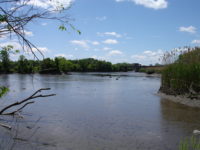The nation’s only geological repository for transuranic nuclear waste, located in southeastern New Mexico, can continue operating under a new agreement by the state, the U.S. Energy Dept., and a Bechtel unit that is facility contractor.
Critics of DOE’s draft document to renew the permit for the Waste Isolation Pilot Plant (WIPP) had requested a public hearing to air concerns related to DOE’s plans for the massive underground storage site. But managers for DOE, the state environmental agency and Bechtel unit, Salado Isolation in Mining Contractors LLC, were able to negotiate modifications that all parties, including stakeholders, agree to, officials announced June 27. The Bechtel unit, called SIMCO, in February replaced Nuclear Waste Partnership LLC as the entity responsible for managing WIPP operations.
The agreement, which now cancels a permit hearing, directs the modified permit to be released by the state at an Aug. 15 public meeting. The final permit will be issued in October and take effect in November, state officials said.
Mark Bollinger, manager of DOE’s Carlsbad, N.M., WIPP field office, said in a statement that the agency "looks forward to continued dialogue and cooperation between New Mexico, DOE and all stakeholders.”
Under the agreement, DOE must provide greater regulatory oversight of the site and follow state safeguards in authorizing disposal of nuclear waste in two newly constructed WIPP storage areas.
Located about 26 miles from Carlsbad, WIPP was built in the 1980s for disposal of defense-generated transuranic waste. The repository is carved out of a 2,000-ft-thick salt bed formed 250 million years ago. Waste is disposed about 2,150 ft below the Earth’s surface in panels mined from the salt bed. A panel consists of seven rooms, each divided by a 100-ft beam of salt. An underground fire in 2014 halted operations at the facility until January 2017.
Critics of the project have contended the DOE has not taken significant steps to identify and site another geological repository for waste storage and is instead expanding the New Mexico facility, presenting a potential risk to local communities. DOE counters that it is authorized under federal law to dispose of 6.2 million cu ft of waste, and that the amount of waste to be stored at the repository has not changed.
Don Hancock, director of the nuclear waste program for watch-dog group Southwest Research and Information Center and a long-time activist, said that while neither government officials nor opponents gained everything desired in reaching the settlement, his organization’s top concerns were addressed. He told ENR that chief among those, for many community groups and the state, was ensuring that DOE be more transparent about steps it is taking to identify another U.S. repository site outside of New Mexico.
DOE balked at being required to provide an annual public update as a condition of maintaining its operations permit, Hancock said. Language was added during negotiations to give the state environmental agency enforcement authority if conditions are not met. “That was important to us,” Hancock said.
The modified permit also enables the state to revoke the permit and begin the re-issuance process should Congress increase WIPP's storage capacity or expand the types of waste it can accept.
A facilitator participated in negotiations, as did Megan McClean, the state environmental agency's acting WIPP program manager. “The process worked given a strong mediator, the participation of the [state agency] secretary, and the willingness of all parties to understand the interests of others rather than sticking to hardline positions,” she said in a statement.






Post a comment to this article
Report Abusive Comment